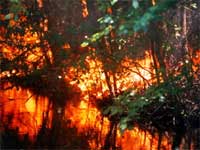Statistics is essentially the process of learning from data. The goal of statistics is to make correct statements or inferences about a population based on a sample.
Almost all natural resource professionals deal with data, for example a wildlife biologist may look at the number of owl packs on a given forest or a fuels specialist may look at the surface fuel loadings present in a prescribed burning block. In either case statistics is used to help us design how the data will be collected collected and to summarize the data after it is collected. Not only do we want to understand how to collect and summarize data we also want to be able to understand data that is published.
 Understanding published data is just as important to us as
natural resource professionals as collecting and summarizing our own
data. Since we are not always able to collect the data we would like
to have we often rely on published data to provide critical
information. For example, it may not be possible to collect fire
history data for completion of a restoration project, so we can use
published data to provide that information.
Understanding published data is just as important to us as
natural resource professionals as collecting and summarizing our own
data. Since we are not always able to collect the data we would like
to have we often rely on published data to provide critical
information. For example, it may not be possible to collect fire
history data for completion of a restoration project, so we can use
published data to provide that information.
However, the results of that study are inferences based on a sampling design, and therefore may be biased or even completely invalid. For this reason it is important for us to not only be able to collect and summarize data our selves but we must interpret published data.
| LESSON 1 |


